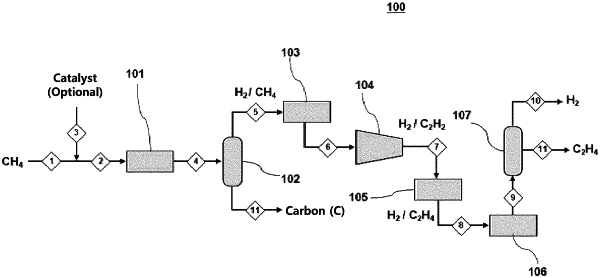| CPC C07C 5/09 (2013.01) [B01J 21/04 (2013.01); B01J 23/745 (2013.01); C01B 3/26 (2013.01); C01B 32/05 (2017.08); C01B 32/162 (2017.08); C01B 32/205 (2017.08); C07C 2/78 (2013.01); C07C 2/80 (2013.01); C07C 2/84 (2013.01); C07C 7/09 (2013.01); C09C 1/48 (2013.01); C01B 2203/0277 (2013.01); C01B 2203/062 (2013.01); C01B 2203/1047 (2013.01); C01P 2006/80 (2013.01); C07C 2521/04 (2013.01); C07C 2523/745 (2013.01)] | 14 Claims |

|
1. A method for producing carbon (C), ethylene (C2H4), and hydrogen (H2) from methane, comprising the steps of:
step a) forming a first product comprising unreacted methane, carbon, and hydrogen through methane pyrolysis by transferring a methane-containing feedstock to a first methane conversion step;
step b) separating a first gaseous mixture containing hydrogen and methane and solid carbonaceous materials from the first product, wherein a hydrogen (H2)/methane (CH4) molar ratio in the first gaseous mixture is adjusted within a range of 1 to 6;
step c) forming a second gaseous mixture containing hydrogen and acetylene through a methane coupling reaction by transferring the first gaseous mixture to a second methane conversion step,
wherein the second methane conversion step is performed through a direct non-oxidative methane coupling reaction by thermal conversion,
wherein in the second methane conversion step, a methane conversion is at least 35% and selectivity for acetylene is at least 60%, and
wherein a hydrogen (H2)/acetylene (C2H2) molar ratio in the second gaseous mixture is adjusted within a range of 20 to 150;
step d) forming a third gaseous mixture containing hydrogen and ethylene by subjecting acetylene in the second gaseous mixture to selective hydrogenation in the presence of a hydrogenation catalyst; and
step e) separating and recovering hydrogen and ethylene, respectively, from the third gaseous mixture.
|